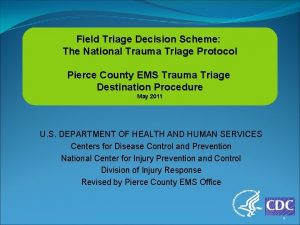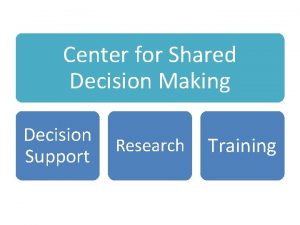The SHARE Approach Essential Steps of Shared Decision






















































- Slides: 54

The SHARE Approach Essential Steps of Shared Decision Making Workshop Course

Module 4 Putting Shared Decision Making Into Practice 2

Module 4 – Purpose To introduce key activities and strategies to consider as part of incorporating shared decision making into practice at your organization, including obtaining leadership support. 3

Module 4 – Learning objectives At the conclusion of this activity, the participant will be able to: Explain why it is important to engage the entire medical practice. Explain roles that different team members can play in implementing shared decision making in practice. Describe the steps required for implementing shared decision making and the use of patient-centered outcomes research (PCOR). Identify current incentives for adopting shared decision making and PCOR decision materials in practice. 4

Tool 8 Putting Shared Decision Making into Practice: A User’s Guide for Clinical Teams 5

Key activities for implementing shared decision making in practice 1. Get leadership buy-in. Implementing shared 2. Develop an implementation team. decision making requires a 3. Select an approach that is tailored coordinated plan. to your practice. 4. Provide training and ongoing support to all staff. 5. Start small, then take it to scale. 6. Create a physical setting for shared decision making. 7. Create a library of evidence-based educational resources and decision aids. 8. Streamline shared decision-making work processes into day-to-day operations. 9. Evaluate the ongoing implementation of shared decision making. Refer to page 3 of Tool 8. 6

Key Activity 1 Getting Leadership Buy-in 7

Leadership buy-in is important Shared decision making may require changes in staff assignments, resource allocations, and workflow. These kinds of changes need to be authorized by your organization’s leaders. 8

Leadership buy-in? Who already has leadership buy-in? § Asked to come to training by leadership Who had to do the persuading? 9

Tool 9 Achieving Patient-Centered Care with Shared Decision Making: A Brief for Administrators and Practice Leaders 10

The Administrators Briefly outlines what implementing PCOR resources via shared decision making involves, and the benefits of doing so. Shared decision making is aligned with the three aims of the U. S. Department of Health and Human Services’ National Quality Strategy – better care, better health, and lower costs. 11

The Administrators Brief Share this tool with your workshop participants to highlight the benefits for implementing shared decision making at your organization. 12

Better care 1 -2 Shared decision making improves patients’ experience of care. Patients find they: Improve their knowledge of the options. Have more accurate expectations of possible benefits and harms. Have less decisional conflict. Reach choices that are more consistent with their values. Participate more in decision making. Complete references are listed on the last two slides. 13

Better health 2 -6 Patients engaged in shared decision making show: Improved health outcomes (e. g. , improved quality of life, better symptom control, improved self-management, and reduced symptoms of depression). Improved treatment adherence. 14

Lowers cost 5 -7 Shared decision making can lower costs. Patients are more likely to select conservative treatment options over elective invasive procedures when they understand the potential benefits and harms. 5, 6 Shared decision making for 11 preference-sensitive conditions/procedures is estimated to result in national cost savings of $9. 2 billion over 10 years. 7 Refer to page 3, Tool 9 for list of conditions/procedures Preference-sensitive conditions are those in which legitimate treatment options exist, each with its own trade-offs. 15

Shared decision making helps you meet national certification requirements Looking to become recognized or certified as a patient-centered medical home (PCMH) or accountable care organization (ACO)? Incorporating shared decision making into your clinical practice can help you meet standards established by the National Committee for Quality Assurance, Accreditation for Ambulatory Health Care, and the Joint Commission (refer to page 5, Tool 9). Who already works in a PCMH or ACO? 16

Once you are back on the job Share the Administrator’s Brief with your leadership and staff to sustain interest. Remind that it only takes one or two people to champion the cause. Do you know anyone who could be a good champion? Perhaps yourself? 17

Tool 8 Putting Shared Decision Making into Practice: A User’s Guide for Clinical Teams 18

Key Activity 2 Form an Implementation Team Refer to page 4, Tool 8. 19

Develop implementation team An in-house team can design an appropriate approach for your setting. Team members may include: § Clinical providers § Health educators § Administrators § Front desk staff 20

Develop implementation team Who else would you invite to be on this team? 21

Develop implementation team Responsibilities include: § Developing an implementation plan. § Reviewing patient support materials. § Conducting training and ongoing coaching. § Monitoring ongoing adoption. 22

Key Activity 3 Select an Approach Tailored to Your Practice Refer to page 5, Tool 8. 23

Start with one or two conditions Identify one or two high-priority health conditions in which you will implement shared decision making. What criteria will you use? Add more conditions once everyone is familiar with shared decision making. 24

Decide who does what Planning team designates roles and responsibilities for each shared decision-making team member. Who will be involved and what will their roles be? 25

Use supporting materials Identify evidence-based patient decision materials to support the shared decision-making process for selected health conditions. AHRQ offers free and easy-to-navigate decision aids and consumer research summaries. Refer to pages 10 -15 of Tool 8 for listing of resources. 26

Decide when to introduce decision aids Choose optimal point in decision-making process to introduce decision aids. § Time of diagnosis? Or afterward? § Part of the office visit? Or mailed in advance? Do staff members review with patient, or does the patient call with questions? Set a standard operating procedure. Refer to page 5, Tool 8 for examples. 27

Address concerns about time constraints Be proactive. Discuss time concerns during training and during implementation. Reassure staff that shared decision making should not take more time than what they were used to doing. Time is biggest barrier Studies have found that clinicians can implement shared decision making without increasing the length of the consultation time. 8 -10 Recall the SHARE Approach video? Share it with your colleagues. 28

Key Activity 4 Provide Ongoing Training and Ongoing Support Refer to page 5, Tool 8. 29

Provide training Train all relevant staff in shared decision making. § Model in-house training on SHARE Approach Workshop (module by module, during staff meetings, during lunch hours, etc. ). § Use the Shared Decision Making Toolkit on the AHRQ Web site to access materials. www. ahrq. gov/shareddecisionmaking You can learn more about training others on the SHARE Approach AHRQ’s Trainer Module. 30

Provide regular feedback and ongoing support Provide ongoing training, feedback, and coaching. One training is not enough to institutionalize shared decision making. Some ongoing training strategies might include: § Video/audio recording patient/provider interactions while practicing shared decision making. § Shadowing trainees and providing feedback. 31

Provide regular feedback and ongoing support Use available AHRQ training support, including a learning network and Web conferences. . Learn more about ongoing support offered by AHRQ at www. ahrq. gov/sh areddecisionmak ing. 32

Discussion What are your thoughts about training others when you return home? What challenges do you foresee? Are there creative ways to address these challenges? 33

Key Activity 5 Start Small, Then Take To Scale Refer to page 7, Tool 8. 34

Start small, and take to scale Pilot shared decision making in one department or for one or two health conditions. Gather needed resources. Test your approach to see what works and what does not. Revise approach, as needed. Expand to additional departments or health conditions. Where do you think the best place to start is in your own practice? 35

Key Activity 6 Create A Physical Setting For Shared Decision Making Refer to page 7, Tool 8. 36

Create a physical setting for shared decision making Address logistical issues in your plan (e. g. , space to house decision aids and equipment). 37

Create a physical setting for shared decision making If your practice decides to have patients review decision aids onsite, create a comfortable space for them to use. Consider using a DVD player and screen, laptop computer, or tablet for patients to review audiovisual aids. 38

Key Activity 7 Create A Library of Evidence-Based Resources and Patient Decision Aids Refer to page 7, Tool 8. 39

Locate evidence-based resources There are many free resources available, including AHRQ’s Effective Health Care Program materials. Refer to pages 10 -12 in Tool 8 for a list of Free decision support resources. 40

Key Activity 8 Streamline Work Processes Refer to page 8, Tool 8. 41

Streamline shared decision-making work processes Use existing workflow processes, such as electronic health records, to integrate decision aids. 42

Key Activity 9 Conduct Ongoing Evaluation Refer to page 9, Tool 8. 43

Conduct ongoing evaluation Evaluation helps you fine-tune the use of shared decision making in your practice. Consider formal evaluation using validated instruments. Refer to page 14, Tool 8 for a list of evaluation resources and tools. 44

Conduct ongoing evaluation Informal evaluation § Gather feedback on what works and what needs improvement. § Share success stories (e. g. , meetings, email, newsletters). 45

Questions and Answers 46

Developing an Action Plan 47

Instructions Work in teams to develop an action plan for implementing shared decision making in your organization for 20 minutes. Choose a reporter. 48

Debrief Report to entire group on key issues you encountered in developing an action plan. 49

Review of Key Takeaways 50

Key Takeaways Get leadership buy-in if you don’t already have it. Share Tool 9 with your colleagues and senior leaders so they understand the benefits of shared decision making. Your implementation team can include a variety of members of your organization (e. g. , clinical staff, administrators, front desk staff, etc. ). Be sure to have one or two champions. 51

Key Takeaways Implementation of shared decision making involves a number of activities. Start by developing an implementation plan. Who does what, when, and how? Choose an approach that works for your setting. Start small and then scale as you get experience. Evaluate your efforts and share feedback with the entire team. Remember that change takes time. Refer to Tools 8 and 9 often as you take steps to help your organization adopt shared decision making 52

Citations 1. Stacey D, Légaré F, Col NF, et. al. Decision aids for people facing health treatment or screening decisions. Cochrane Database Syst Rev. 2014 Jan 28; 1: CD 001431. Pub. Med PMID: 24470076 (2014 Systematic Review; 113 studies; 34, 444 participants). 2. O’Connor A. M. , Llewellyn-Thomas, H. A. , Flood, A. B. Modifying unwarranted variations in health care: shared decision making using patient decision aids. Health Aff (Millwood) 2004; Suppl Variation: VAR 63 -72. PMID: 15471770. 3. Wilson S. R. , Strub P. , Buist A. S. , et al. Better Outcomes of Asthma Treatment (BOAT) Study Group. Shared treatment decision making improves adherence and outcomes in poorly controlled asthma. Am J Respir Crit Care Med 2010 Mar 15; 181(6): 566 -77. PMID: 20019345. 4. Naik A. D. , Kallen M. A. , Walder A. , et al. Improving hypertension control in diabetes mellitus: the effects of collaborative and proactive health communication. Circulation 2008 Mar 18; 117(11): 1361 -8. PMID: 18316489. 5. Clever S. L. , Ford D. E. , Rubenstein L. V. , et al. Primary care patients’ involvement in decision-making is associated with improvement in depression. Med Care 2006 May; 44(5): 398 -405. PMID: 16641657. 53

Citations 6. Da Silva D. Evidence: Helping people share decisions. A review of evidence considering whether shared decision making is worthwhile. 2012 June. London, England: Health Foundation. 7. Schoen C. , et al. Bending the curve: options for achieving savings and improving value in U. S. health spending. The Commonwealth Fund. Commission on a High Performance Health System. December 2007 http: //www. commonwealthfund. org/use_doc/Schoen_bendingthecurve_1080. pdf 8. Duncan E. , Best C. , Hagen S. Shared decision making interventions for people with mental health conditions. Cochrane Database Syst Rev 2010 Jan 20; (1): CD 007297. PMID: 20091628. 9. Hamann J. , Langer B. , Winkler V. , et al. Shared decision making for inpatients with schizophrenia. Acta Psychiatr Scand 2006 Oct; 114(4): 265 -73. PMID: 16968364. 10. Loh A. , Simon D. , Wills C. E. , et al. The effects of a shared decisionmaking intervention in primary care of depression: a clusterrandomized controlled trial. Patient Educ Couns 2007 Aug; 67(3): 324 -32. 54 PMID: 17509808.
 Objectives of decision making
Objectives of decision making Dividend decision in financial management
Dividend decision in financial management 10 essential shared capabilities
10 essential shared capabilities Hoy model
Hoy model Prsb shared decision making
Prsb shared decision making Lung cancer screening shared decision making tool
Lung cancer screening shared decision making tool Essential non essential fatty acids
Essential non essential fatty acids Shared responsibility approach
Shared responsibility approach The share approach
The share approach Share approach
Share approach The share approach
The share approach Social work code of ethics
Social work code of ethics Decision tree and decision table examples
Decision tree and decision table examples 5 step decision making process
5 step decision making process Chapter 11 decision making and relevant information
Chapter 11 decision making and relevant information Engineering ethics rules
Engineering ethics rules Eight steps of decision making process with examples
Eight steps of decision making process with examples Classical administrative and political decision making
Classical administrative and political decision making Latane and darley decision tree
Latane and darley decision tree Steps that enable you to make a healthful decision
Steps that enable you to make a healthful decision Steps that enable you to make a healthful decision
Steps that enable you to make a healthful decision 7 steps of problem solving and decision making
7 steps of problem solving and decision making Kerridge's decision making model
Kerridge's decision making model List the steps in the paced decision making process
List the steps in the paced decision making process National trauma triage protocol
National trauma triage protocol Vroom's decision tree approach
Vroom's decision tree approach Information approach to decision usefulness
Information approach to decision usefulness Importance of decision usefulness theory in accounting
Importance of decision usefulness theory in accounting Decision oriented evaluation approach
Decision oriented evaluation approach Decision tree approach
Decision tree approach Decision making approach
Decision making approach Locomotor movements list
Locomotor movements list Coverdale's 'systematic approach
Coverdale's 'systematic approach Sales comparison approach formula
Sales comparison approach formula Hr score
Hr score Programming
Programming Language experience activity
Language experience activity Hertfordshire steps approach
Hertfordshire steps approach Steps of divide and conquer approach *
Steps of divide and conquer approach * Virtual circuits and datagram networks
Virtual circuits and datagram networks Cognitive approach vs behavioral approach
Cognitive approach vs behavioral approach Country attractiveness matrix
Country attractiveness matrix Multiple approach avoidance
Multiple approach avoidance Cognitive approach vs behavioral approach
Cognitive approach vs behavioral approach What is research approach definition
What is research approach definition Traditional approach to system development
Traditional approach to system development Tony wagner's seven survival skills
Tony wagner's seven survival skills Hình ảnh bộ gõ cơ thể búng tay
Hình ảnh bộ gõ cơ thể búng tay Lp html
Lp html Bổ thể
Bổ thể Tỉ lệ cơ thể trẻ em
Tỉ lệ cơ thể trẻ em Chó sói
Chó sói Chụp tư thế worms-breton
Chụp tư thế worms-breton Chúa sống lại
Chúa sống lại Môn thể thao bắt đầu bằng chữ đua
Môn thể thao bắt đầu bằng chữ đua












































































